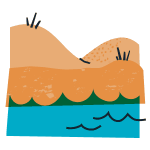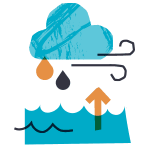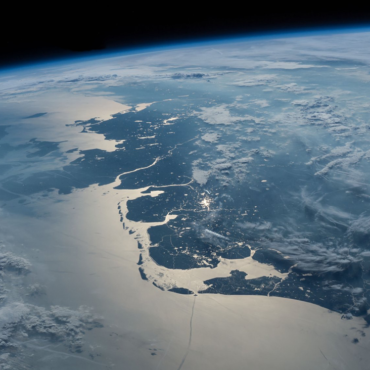The climate is changing: the earth is warming up and sea levels are rising, with an increasing impact on our ecosystems, the way we grow our food and the way we live. A large number of challenges converge in the Wadden coast area.
Programme towards a Rich Wadden Sea (PRW) is working on this together with various partners. We asked Strootman Landscape Architects to support PRW in developing a strategy for climate adaptation along the Wadden coast. An adaptation strategy that sets the agenda, inspires and looks ahead towards a citizen, integrated, climate-robust future in the 21st century. The report Climate adaptation of the Wadden coast region in the 21st century – visualising tasks and future is now ready.
Climate Adaptation Summit (CAS)
The immediate reason for drawing up the climate adaptation strategy for the Wadden coast area is the Climate Adaptation Summit (CAS) that took place in the Netherlands on January 25, 2021. This global summit contributes to the action of the Global Commission on Adaptation (GCA) to gain more support for climate adaptation worldwide. Around the CAS, the municipality of Groningen organizes with various partners and in collaboration with GCA a climate adaptation week. PRW was a partner in this.
Inspiring and setting the agenda
We provide a perspective on the future of the Wadden Sea coast in the form of an adaptation strategy. In other words: what is the problem and what can we do about it? We look ahead and focus on the challenges and opportunities that lie ahead for the area. In doing so, we offer inspiration to similar deltas worldwide. Where there is currently a lot of effort around climate mitigation (including energy transition), our focus is on climate adaptation with measures to adapt to the changing climate.
This adaptation strategy is not intended to be a set policy, but to inspire and put on the agenda. To be able to make responsible choices now and anticipate future developments, we are looking far ahead, towards 2100. This takes us beyond the horizon used by various exploratory studies and the Wadden Area Agenda 2050.
There are many uncertainties surrounding the expected climate effects in the longer term. However, today’s choices determine the playing field in which future actions will take place. It is important not to limit the choices available in the future. For this reason, we consciously look beyond 2050 and propose adaptive solutions that we can anticipate now. In doing so, we seek to connect to existing, positive developments that are already taking place.
The delineation focuses on the Wadden Sea coast area, from the salt marshes outside the dikes in the north to the peat areas and the stream valleys in the south, and from Den Helder in the west to the border with Germany in the east. This makes the story an overarching Wadden Sea perspective. The Wadden Sea, including the tidal flats and islands, has not been considered here; many area processes are already underway and we are looking for the interaction between the Wadden Sea and the land. Finally, we provide a stacked perspective that is still lacking in some places: we come up with solutions that not only contribute to climate adaptation but also have positive effects for agriculture, biodiversity and quality of life.
PRW was supported in this process by Strootman Landscape Architects and provided valuable input and robust discussions in several working sessions with the sounding board group and experts.
Tasks
First the most important challenges as a consequence of climate change were mapped out:
- Temperature rise
- Changing precipitation patterns
- Sea level rise and increasing salinisation
- Changing storm regimes and ocean acidification
Especially the first three will cause noticeable effects in the Wadden Sea region. A rise in temperature will have negative effects on nature and agriculture, and it will also become noticeably warmer. Changing precipitation patterns will lead to more frequent droughts and flooding, with the associated negative effects. Rising sea levels will affect water safety, salinisation, freshwater discharge and marine life in the Wadden Sea. These effects are not only increasing, they are also becoming more unpredictable.
Action perspective: 3 courses
Looking to the future, we see three major climate adaptation challenges for the Wadden Sea region:
- Ensuring a safe coast,
- Making optimal use of freshwater and
- Counteracting the decline in biodiversity.
These tasks stem from the effects of climate change.
By choosing the right measures we create added value and can simultaneously fulfil other ambitions that will make the area more robust and richer. Examples are strengthening the landscape identity by making cultural history visible, or new opportunities for (circular) agriculture and recreation and tourism, but also more mitigating objectives such as reducing and capturing CO2 emissions.
Follow-up
It will be clear that we face a major challenge. All the experts we consulted endorse this. At the same time, anticipating the challenges also presents an opportunity to make the area more interesting, richer and more attractive. The questions before us are: how do we deal with the challenges and what choices do we make? What are we doing now, what will the landscape look like in 80 years, and how do we get there? With the information and the possible solutions we can create a dialogue with each other.
The seven hotspots on the map can help. These are places where many tasks converge and projects are already underway, but where a time horizon of 2100 has not yet been taken into account. We invite everyone to use this report to reflect on how residents, entrepreneurs and recreational users in the Wadden Sea region can continue to live comfortably, earn a good living and enjoy a rich environment in the future.
Would you like to know more?
Please contact Jeroen van Herk or Titian Oterdoom. You can find their contact details here.



